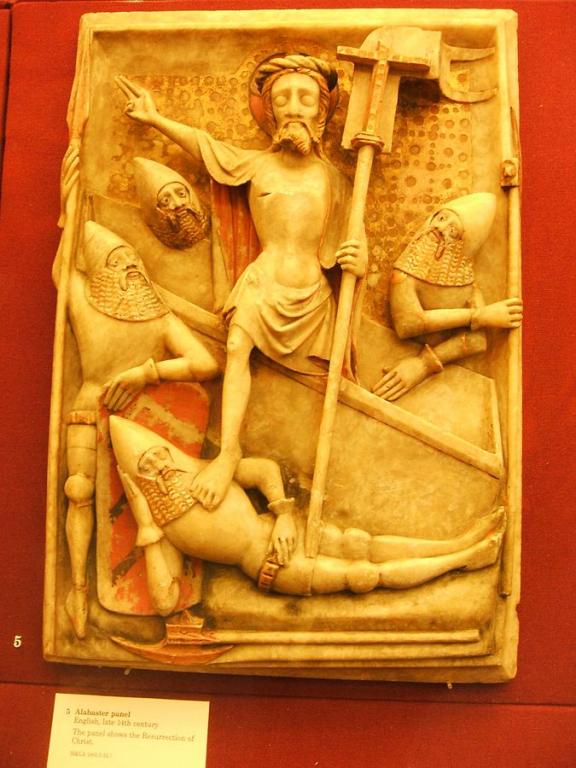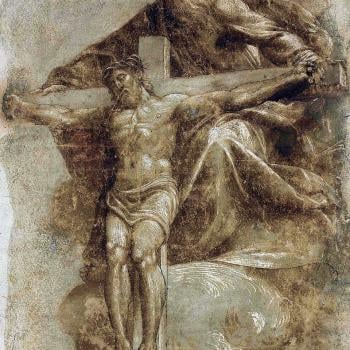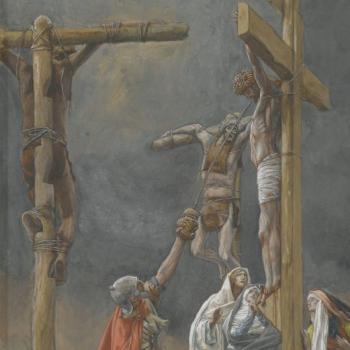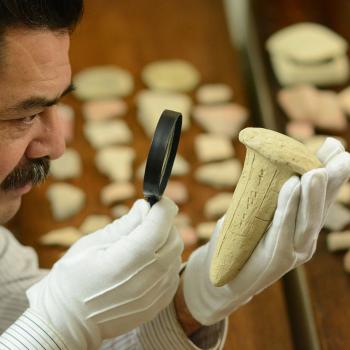
Holy Week is like a garment, blanket or tapestry made of one cloth, and without any holes in it. There is one golden thread that ties together all the events the church celebrates this week. That golden thread is Jesus and his mission. So while we may tend to think that everything culminates at Good Friday with the cancellation and eradication of sin in Jesus’ death on the cross, or perhaps that it all comes crashing down and get swept away on Holy Saturday as Jesus lies buried in the grave, we need to realize that the story’s not over. Jesus rises from the grave. But even here we must be careful to guard against thinking of the events as simply one patch on a very spotty quilt. The entire Bible is the story of God’s deliverance and healing of the nations and world through his Suffering Servant and chosen people. So how does all this bear on Holy Week and what immediately follows—Easter Sunday?
Certainly, the idea of Holy War highlighted on Palm Sunday comes into play. Maundy Thursday, Good Friday, Holy Saturday and Easter Sunday continue this theme. God delivers his people from bondage in Egypt through his suffering servant Jesus and takes them to the Promised Land. There they serve as a royal priesthood and holy nation formed by the Messianic seed of promise and who are children of Abraham’s faith. They are called to bless all peoples for the glory of God on earth. The first epistle of Peter puts it this way:
But you are a chosen race, a royal priesthood, a holy nation, a people for his own possession, that you may proclaim the excellencies of him who called you out of darkness into his marvelous light (1 Peter 2:9; ESV).
So, what does this entail for our understanding of Easter? And how might making sure we see all the events of Holy Week and the “Old” and “New” Testaments as one piece be important to our life and witness? If Easter is the whole progression of Holy Week, and if the “Old” and “New” Testaments are really “Older” and “Newer,” or the beginning and end of one narrative, what will that entail for human existence?
Many view Easter as a form of validation of Jesus’ claims and actions prior to going to the cross. In other words, the resurrection serves as apologetic proof. Certainly, this emphasis has its place. For example, in his speech at Pentecost, the Apostle Peter makes clear that God validated Jesus’ identity and activity and that the resurrection demonstrates that he is Lord and Christ (Acts 2:22-36). While this is certainly true, there is indeed more to the tapestry.
Many will also emphasize that Easter is the elevation of believers from sin and death to eternal life involving purification from sin and personal salvation. Here one calls to mind Paul’s words that if Jesus is not raised from the dead, our faith is meaningless, and we are still dead in our sins (1 Corinthians 15:17). The point on elevation, then, is certainly part of the fabric. But there is still more to the tapestry of Scripture.
It is also important to conceive of Easter as the beginning of the new creation and vocation to victorious and abundant life in the Promised Land. Again, if as we have argued in the Good Friday essay, Good Friday’s relation to Passover is not a coincidence, but an indication that Jesus is leading his people out of bondage and into the Promised Land, then we must come to terms with an all-encompassing and earth-dwelling view of salvation that looks very different than the perspective that God will whisk us away from this evil world to an eternal abode in the sweet bye-and-bye. On this “whisk away” view, the church is simply a weigh-station where we can unload some of our baggage for an easier lift off.
In an interview with Christianity Today, N.T. Wright makes the following assessment of the resurrection, which bears on what has been stated so far:
In the West we have been so seduced by the Platonic vision of ‘heaven’ that the resurrection of Jesus is seen simply as the “happy ending” after the crucifixion, and as the prelude to his “going to heaven” so that we can go and join him there later. This misses the central point that the resurrection of Jesus is the beginning of the new creation, in which we are to share already in the power of the Spirit. This affects everything, from prayer and the sacraments to mission and service to the poor. And yes, it ought to be reflected liturgically in whatever tradition we stand. Playing this back to the meaning of the cross, we realise that new creation is now happening because the dark powers that have kept the world enslaved to sin and death have been defeated. Perhaps there are themes there which could be brought more explicitly into our Good Friday commemorations as well. But the Christian life is meant to be a sustained and focused celebration of that achievement. Present suffering and struggle are held within the narrative of Jesus’ victory on the one hand and the final redemption of all creation on the other. That is what climactic passages like Romans 8 are all about. I would love to see churches trying out different ways of embodying all of this in the way we order our public worship.[1]
If we take into account the entire biblical tapestry, we will come to see the church as a royal priesthood and holy nation, a people belonging to God (1 Peter 2:9). We will realize that the church is not a building but a community that participates in Jesus’ mission as the New Moses, Royal Priest, and Passover Lamb. Our liturgy is not a private ritual, but a public pageant. Our aim is not simply about proving a point that Jesus is Lord or getting people saved. Rather, the proof is in the pudding that Holy Week and Easter Sunday are ultimately about God making all creaturely life whole in and through Jesus in the Spirit of Pentecost who raises Jesus from the dead.
We can find no better liturgical explanation for seeing Easter in view of the entire biblical tapestry and the entire biblical tapestry in view of Easter than the following reflection from the Orthodox Church. Thomas Hopko writes:
In the Orthodox Church the feast of Easter is officially called Pascha, the word which means the Passover. It is the new Passover of the new and everlasting covenant foretold by the prophets of old. It is the eternal Passover from death to life and from earth to heaven. It is the Day of the Lord proclaimed by God’s holy prophets, “the day which the Lord has made” for His judgment over all creation, the day of His final and everlasting victory. It is the Day of the Kingdom of God, the day “which has no night” for “its light is the Lamb” (Rev 21.22–25).[2]
In view of what has been claimed in this entry about Easter, what then is the import for the life and liturgy of the church? How will it affect our way of being in the world as the community of the Royal Priest and Pascal Lamb who conquers Egypt and leads us as his royal priesthood, holy nation and temple people to the Promised Land? Pray that God’s heavenly kingdom will come to earth. Partake of the sacraments as being baptized into Jesus as he crosses the Red Sea and Jordan River, and as we drink of him for nourishment as we pass through the wilderness into the land flowing with milk and honey. Provide for the well-being of the widow, orphan, and alien in their distress (Deuteronomy 10:18; James 1:27). Participate in the Easter pageantry that does not end on Sunday or with the close of Eastertide. Rather, it carries on throughout the year. The golden thread of Jesus and his mission weaves its way through the tapestry of the church calendar until Christ the King Sunday, which celebrates his reign over all the nations and creation, and which will come to fruition with the dawning of the new heavens and the new earth.
This golden threaded tapestry weaves all saints together as the church militant, the church expectant, and the church triumphant throughout the ages and across the globe. Together we chant “Jesus is risen! He is risen indeed!” Together we cry “Come, Lord Jesus, come!” Amen.
_______________
[1]For more on Wright’s interview with Mike Bird, see “N. T. Wright: The Church Continues the Revolution Jesus Started,” Christianity Today, October 13, 2016; https://www.christianitytoday.com/ct/2016/october-web-only/n-t-wright-jesus-death-does-more-than-just-get-us-into-heav.html (accessed on 3/29/2020). See also N.T. Wright, Surprised by Hope: Rethinking Heaven, the Resurrection, and the Mission of the Church (New York: HarperOne, 2008); The Day the Revolution Began: Reconsidering the Meaning of Jesus’s Crucifixion (New York: HarperOne, 2016).
[2]Thomas Hopko, “Easter Sunday: The Holy Pascha,” in The Orthodox Faith, vol. II—Worship, illustrated by Andrew Tregubov, rev. ed. (New York: St Vladimir’s Seminary Press, 2016); https://www.oca.org/orthodoxy/the-orthodox-faith/worship/the-church-year/easter-sunday-the-holy-pascha (accessed on 3/29/2020).












